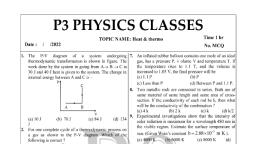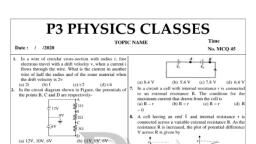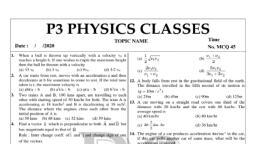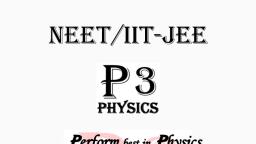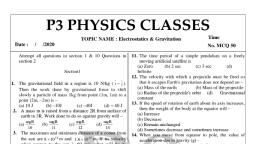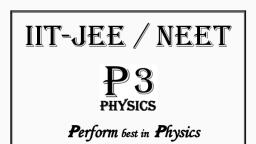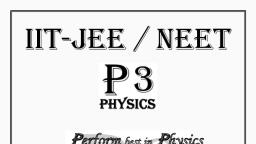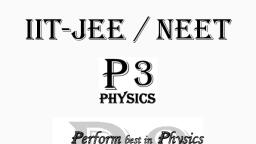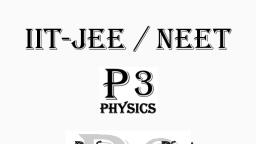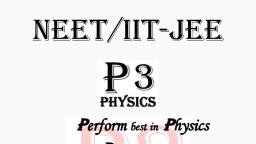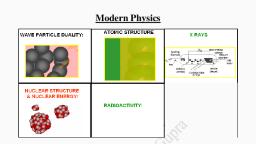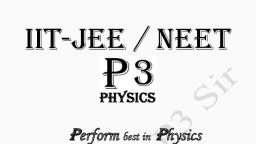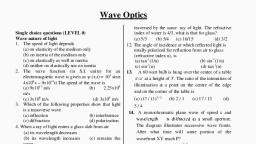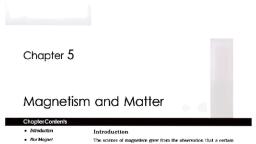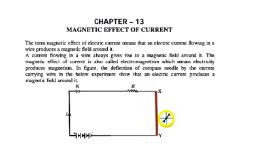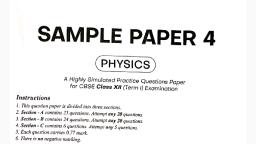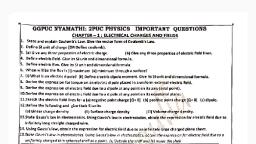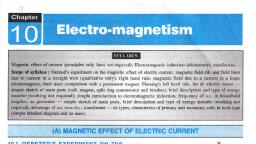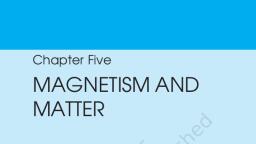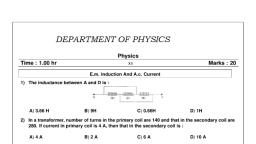Page 2 :
Magnetism, , Magnetism Section-1: Magnetic Force on moving Charge, Magnetic Force, The fundamental nature of magnetism is the interaction of moving electric charges. Electric force acts on an, electric charge whether it is moving or not. However magnetic force acts only on moving charges and, current carrying wires., A magnetic field can be established by a permanent magnet, by a moving charge or by an electric, current. This magnetic field, in turn, exerts force on other moving charges and current carrying wires., Magnetic field:, , Direction of magnetic field is defined in one of the direction along the line where, magnetic force on a moving charge is zero., If a particular is maintained to move perpendicularly maximum force ats on the, moving charge following right hand rule, , Magnetic force acting on a moving charge in a magnetic field:, IN General for motion in any direction at an angle θ, , Fα qv Sin θ, , F= qvB Sin θ, In vector form, , , , Fm = q( v × B ), , . The strength of the magnetic field is measured by a quantity called magnetic field induction B ., Wb Weber , Unit of magnetic induction: 2 , , m metre2 , Wb, (In the honour of the scientist Nikola Tesla), 1 Tesla (T) 1 2 S.I. unit = Tesla, m, 1 Gauss = 104 Tesla C.G.S. unit = Gauss, , Three rules to find the direction of Fm :(a) Fleming’s left hand rule: According to this rule, the index finger, the middle finger and the thumb of the left, hand are stretched in such a way that they are mutually perpendicular to each other. If the index finger shows, , d, , , B
Page 3 :
the direction of the magnetic field ( B ) and the middle finger shows the direction of the velocity of positive, , , charge ( v ), then the thumb will give the direction of the magnetic force ( Fm )., , If the charge is negative then Fm will be in a direction opposite to that shown by the thumb., (b) Right hand thumb rule: According to this rule, the four fingers of the right hand are curled and the thumb, , is outstretched. If the curled fingers show the sense of rotation from v to B through the smaller angle, , between them, then the outstretched thumb points in the direction of the magnetic force Fm if the charge is, positive., , If the charge is negative then Fm will be in a direction opposite to that shown by the thumb., (c) Right hand palm rule: According to this rule, the four fingers of the right hand are kept straight and the, thumb is outstretched. Now the straight four fingers show the direction of magnetic field ( B ) and the, , thumb shows the direction of the velocity of positive charge ( v ), then the slapping sense of the palm will, , show the direction of magnetic force ( Fm )., , If the charge is negative then Fm will be in a direction opposite to the slapping sense of the palm., , , , →Since Fm v , the power delivered by the magnetic force Fm at any instant is, , Pm F v 0, Thus, the magnetic force does not perform any work on the charged particle. In other words magnetic field is, a power less field., , , , , → Since Fm v it can change only the direction of v but it cannot change the magnitude of v . Thus the speed of, the particle remains constant throughout the motion of the charged particle in the magnetic field., Hence the change in kinetic energy K = 0 for any interval., , Path of a charged particle in uniform magnetic field:, , , The path of a charged particle is thrown in uniform magnetic field depends on the angle between v and B ., Depending on different values of , following cases are possible., , Case I: = 0° i.e. v and B are parallel., B, Consider a uniform magnetic field B. A particle of mass m and charge q is projected with, , m, , initial velocity v in the direction of the magnetic field lines., v, , q, , , , Since v and B are parallel v × B = 0 Fm 0, i.e. the particle will continue to move along a straight line with a constant velocity., , , Case II: = 180° i.e. v and B are opposite., , B, , The particle is projected with initial velocity v opposite to the direction of magnetic field., , , , , Since v is opposite to B v × B = 0 Fm 0, i.e. the particle will continue to move along a straight line with a constant velocity., , , v, , m, , q, , , , Case III: = 90° i.e. v and B are perpendicular., The particle is projected with initial velocity v perpendicular to the direction of magnetic field., In this case the particle will move in a uniform circular motion with constant tangential speed v. Here the magnetic, force will provide the necessary centripetal force as shown in the figure., The magnitude of Fm = qvB, v, To find radius R of the circle:, Fm = qvB, v, This Fm will provide the necessary centripetal force, R, Fm = maR, , mv 2, q vB =, R, , , , To find angular velocity :, v, , , R, , FM, , mv *, R=, qB, , , , qB, m, , To find time period T of revolution:, , *, , O, , Note: is independent of v., , , FM, , m, +q
Page 4 :
*, , 2m, 2R 2 mv , , T=, = , , Note: T does not depend on v., T, qB, v, v qB , Note: If the speed of the particle is less, the circle is small and if the speed is more, the circle is large., However, the variation in speed does not affect the angular velocity and the time period of motion of the particle., Specific charge: Charge per unit mass is called the specific charge. It is denoted by ., , , , q *, m, , So the above formulae can be written in terms of as, , R, , Case IV: is other than 0°, 90° or 180°., , v, B, , = B, , and, , T=, , 2, B, , In this case the particle is projected in a uniform magnetic field B with velocity v at an angle with the magnetic, field vector. The path of the particle will be in the form of a helix., B, We can think of the motion of this particle for the two components of velocity:, v, v cos and v sin., m , The v cos component is parallel to the magnetic field and hence the particle will, q, move in a straight line with velocity v cos along the field line., The v sin component is perpendicular to the magnetic field and hence the particle, will move in a circle with a constant tangential speed v sin., The radius of the circle and hence of the helix will be, 2m, mv sin *, The time *period of this circular motion will be T , R, qB, qB, Note: Here T does not depend on speed v., The combination of above two motions is a uniform helical motion., To find pitch of the helix: The pitch of the helix is the distance between two consecutive turnings of the helical path., This will be the distance covered by the particle along the axis when it completes one rotation, , *, , 2 mv cos , qB, , Electromagnetic field:, Consider a region containing electric field and magnetic field of intensity E and B, B, respectively. Consider a particle of mass m and having charge q which is projected in this combined, , field (electromagnetic field) with velocity v ., m, v, q, The electric force acting on the particle will be FE qE, Pitch = v cos × T, , , , Pitch =, , The magnetic force acting on the particle will be, , FM q(v B), , E, , The resultant force on the particle will be the vector sum of these two forces. This resultant force is called, Electromagnetic Force or Lorenz Force., FLorentz = q[ E + ( v × B )], , Electromagnetic force, , Magnetic force on a current carrying conductor kept in an external, magnetic field:, In more general form, , , , , , , , dFm i dl B, This is the ampere’s, , force acting on dl element of, the current carrying wire., , B, , , dl, i
Page 5 :
Magnetic force, magnetic, force, , Magnetic, torque, , hall effect, ., , 1. strong magnetic filed is applied on a stationary, electron, then :, (a) the electron moves in the direction of the field., (b) the electron moves in an opposite direction ., (c) the electron remains stationary ., (d) the electron starts spinning ., 2. A beam of charged particles is passed through a, magnetic field. The work done on the beam by the, field is :, (a)Zero, (b) Dependent on the speed of beam, (c) Dependent on the deflection of beam, (d) Dependent on the magnetic field B., 3. The radius of the curvature of the path of a charged, particle in a uniform magnetic field is directly, proportional to:, (a) the charge on the particle, (b) the momentum of the particle, (c) the energy of the particle, (d) the intensity of the field ., 4. A positively charged particle projected forwards east, is deflected towards north by a magnetic field. The, field may be, (a) towards west, (b) towards south, (c) upward, (d) downward, 5. A charged particle is whirled in a horizontal circle on, a frictionless table by attaching it to a string fixed at, one point. If a magnetic field is switched on it the, vertical direction, the tension in the string, (a) will increase, (b) will decrease, (c) will remain the same (d) may increase or, decrease, 6. Which of the following particles will experience, maximum magnetic force (magnitude) when, projected with the same velocity perpendicular to a, magnetic field?, (a) electron (b) proton, (c) He+, (d) Li++, 7. A beam consisting of protons and electrons moving, at the same speed goes through a thin region in, which there is a magnetic field perpendicular to the, beam. The protons and the electrons, (a) will go undeviated, , (b) will be deviated by the same angle and will not, separate, (c) will be deviated by the different angles and, hence separate, (d) will be deviated by the same angle and but will, separate, 8. A particle moves in a region having a uniform, magnetic field and a parallel, uniform electric field., At some instant, the velocity of the particle is, perpendicular to the field direction. The path of the, particle will be, (a)a straight line, (b)a circle, (c)a helix with uniform pitch, (d) a helix with non-uniform pitch, 9. A proton and an alpha particle are projected with, the same K.E. at right angles to a uniform magnetic, field. Which one of the following statement will be, true ?, (a) the particle will be bent in a circular path with a, smaller radius than that of proton ., (b) The radius of the path of the alpha particle will, be grater than that of the proton., (c) The alpha particle and the proton will be bent in, a circular path with the same radius., (d) the alpha particle and the proton will go through, the field in a straight line, 10 .The time rate of work done by the magnetic field on, a charged particle moving on a helical path, is, (a) qB, (b) qB/v, (c) qbv2, (d) zero, 11. A neutron , a proton , an α-particle enter a region of, uniform, C, magnetic, B, P, field with, equal, D, velociti, A, es. The, magneti, c field, is, perpendicular to plane of paper and directed, downwards. The tracks particle are labeled in the
Page 6 :
figure as A,B,C and D. The electron follows the, track :, (a) A, (b) B, (c) C, (d) D., 12. A proton, a deuteron and an α – particle having the, same kinetic energy are moving in circular, trajectories in a constant magnetic field. If rP, r P and, r denote respectively the radii of the trajectories of, these particles, then, (a) r rp rd, (b) r rd rp, (c) r rd rp, , (d) rp rd r, , 13. An ionized gas contains both positive and negative, ions. If it is subjected simultaneously to an electric, field along the +x-direction and a magnetic field, along the +z-direction, then, (a) positive ions deflect towards +y-direction and, negative ions towards –y direction, (b) all ions deflect towards +y-direction, (c) all ions deflect towards -y-direction, (d) positive ions deflect towards –y-direction and, negative ions towards + y-direction, 14. Two particles X and Y having equal charges, after, being accelerated through the same potential, difference, enter a region of uniform magnetic field, and describe circular paths of radii R1 and R2, respectively. The ratio of the mass of X to that of Y, is), (a) (R1 / R2)1/2, (b) R2 / R1, (c) (R1 / R2)2, (d) R1 / R2, 15. The time period of a charged particle undergoing a, circular motion in a uniform magnetic field is, independent of its, (a) speed (b) mass (c) charge (d) magnetic induction, 16. A charged particle moves through a magnetic field, perpendicular to its direction. Then, (a) kinetic energy changes but the momentum is, constant, (b) the momentum changes but the kinetic energy is, constant, (c) both momentum and kinetic energy of the particle, are not constant, (d) both momentum and kinetic energy of the particle, are constant, 17. If an electron and a proton having same momenta, enter perpendicular to a magnetic field, then, (a) curved path of electron and proton will be same, (ignoring the sense of revolution), (b) they will move undeflected, (c) curved path of electron is more curved than that of, the proton, (d) path of proton is more curved., 18. A particle of mass M and charge Q moving with, velocity v describes a circular path of radius R when, subjected to a uniform transverse magnetic field of, induction B. The work done by the field when the, particle completes one full circle is, Mv 2 , (a) , 2R, R , , (c) BQ2R, , (d) BQv2R, , 19.The magnetic field of a U magnet is parallel to the, surface of this paper with the N-pole on the left, side. A conductor is placed in the field so that it is, perpendicular to this page. When a current flows, through conductor out of the paper , it will tend to, move:, (a) downward, (b) upward, (c) to the right, 20. A conducting circular loop of radius r carries a, constant current i. It is placed in uniform magnetic, field B such that B is perpendicular to the plane of, the loop. The magnetic force acting on the loop is:, (a) irB, (b) 2πirB, (c) zero, (d) πirB, 21. A charged particle is released from rest in region of, steady and uniform electric and magnetic fields, which are parallel to each other. The particle will, move in a, (a) straight line (b) circle (c) helix (d) cycloid, 22. A uniform electric field and a uniform magnetic, field are acting along the same direction in a certain, region. If an electron is projected along the direction, of the fields with a certain velocity then, (a) its velocity will increase, (b) its velocity will decrease, (c) it will turn towards left of direction of motion, (d) it will turn towards right of direction of, motion, 23. A particle of mass m, charge Q and kinetic energy T, enters a transverse uniform magnetic field of, induction B. After 3 seconds the kinetic energy of, the particle will be: [CBSE (AIPMT)2008], (a) 4T, (b) 3T, (c) 2T, (d) T, 24. Under the influence of a uniform field, a charged, particle moves with constant speed V in a circle of, radius R. The time period of rotation of the particle:, [CBSE (AIPMT)2009], (a) Depends on V and not on R, (b) Depends on R and not on V, (c) Is independent of both V and R, (d) Depends on both V and R, 25., A particle having a mass of 10-2kg carries a, charge of 5 x 10-8C. The particle is given an initial, horizontal velocity of 105 ms-1 in the presence of, , , , (i), , B should be perpendicular to the direction of, , , velocity and E should be along the direction, of velocity., , , , , (ii) Both B and E should be along the direction of, velocity., , , (b) zero, , , , , , electric field E and magnetic field B . To keep, the particle moving in a horizontal direction, it is, necessary that:, , , , (iii) Both B and E are mutually perpendicular and, perpendicular to the direction of velocity.
Page 7 :
, , (iv) B should be along the direction of velocity, , (a), , , , and E should be perpendicular to the direction, of velocity., Which one of the following pairs of statements is, possible? [CBSE(AIPMT)Mains-2010], (a) ii and iii, (b) ii and iv, (c) i and iii, (d) iii and iv, 26., An electron moves at right angle to a magnetic, field of 1.5 x 10-2 tesla with a speed of 6 x 107, m/s. If the specific charge of the electron is 1.7, x 1011 coulomb/kg, the radius of the circular, path will be:, (a) 2.9 cm, (b) 3.9 cm, (c) 2.35 cm, (d) 2 cm, 27., The magnetic force acting on a charged particle, of charge 2 C in a magnetic field of 2T, acting in y direction, when the particle velocity, ^, , ^, , is (2 i 3 j ) 106 ms 1 , is:, [CBSE(AIPMT)2009], (a) 8 N in –z direction, (b) 4N in z direction, (c) 8N in y direction, (d) 8N in z direction., 28., An electron having momentum 2.4 x 10-23 kgm/s enters a region of uniform magnetic field of, 0.15T. The field vector makes an angle of 300, with the initial velocity vector of the electron., The radius of the helical path of the electron in, the field shall be:, [AMU-2011], (a) 2 mm, (b) 1 mm, (c), 29., , 3, mm, 2, , (d) 0.5 mm, , A proton carrying 1.5MeV kinetic energy is, moving in a circular path of radius R in uniform, magnetic field. What should be the energy of an, -particle to describe a circle of same radius in, the same field? [AIPMT Mains 2012], (a) 0.5 MeV, (b) 4 MeV, (c) 2 MeV, (d) 1 MeV, 30., The magnetic field in a certain region of space, is given by B = 8.35 x 10-2 i T. A proton is shot, into the field with velocity v = (2 x 105t + 4 x, 105J) m/s. The proton follows a helical path in, the field. The distance moved by proton in the, x-direction during the period of one revolution, in the yz-plane will be [AMU 2012], (a) 0.053 m, (b) 0.136 m, (c) 0.157 m, (d) 0.236 m, (Mass of proton = 1.67 x 10-27 kg), 31., When a proton is released from rest in a room,, it starts with an initial acceleration a 0 towards, west. When it is projected towards north with a, speed v0 it moves with an initial acceleration, 3a0 towards west. The electric and magnetic, fields in the room are:, [NEET 2013], , (b), (c), (d), 32., , (a), (c), 33., , (a), (c), , ma0, 3ma0, east ,, up, e, ev0, ma0, 3ma0, east ,, down, e, ev0, ma0, 2ma0, west,, up, e, ev0, ma0, 2ma0, west,, down, e, ev0, A proton and an alpha particle both enter a, region of uniform magnetic field B, moving at, right angles to the field B. If the radius of, circular orbits for both the particles is equal and, the kinetic energy acquired by proton is 1 MeV,, the energy acquired by the alpha particle will, be: [ReAIPMT 2015], 1 MeV, (b) 4 MeV, 0.5 MeV, (d) 1.5 MeV, An electron is moving in a circular path under, the influence of a transverse magnetic field of, 3.57 x 10-2 T. If the value of e/m is 1.76 x 1011, C/kg, the frequency of revolution of the, electron is [NEET-II-2016], 6.28 MHz, (b) 1 GHz, 100 MHz, (d) 62.8 MHz, , Magnetic force on current carrying loop, 34. In an experiment electrons are accelerated, from, rest, by applying a voltage of 500 V. Calculate, the radius of the path if a magnetic field 100 m, T is then applied., [Charge of the electron = 1.6 x 10-19C Mass of the, electron = 9.1 x 10-31 kg] [JEE Mains – 2019], (a) 7.5 x 10-4 m (b) 7.5 x 10-3 m, (c) 7.5 m, (d) 7.5 x 10-2 m, 35. A proton and an -particle (with their masses in, the ratio of 1 : 4 and charges in the ratio of 1 :, 2) are accelerated from rest through a potential, difference V. If a uniform magnetic field (B) is, set up perpendicular to their velocities, the ratio, of the radii rp : ra of the circular paths described, by them will be:, [JEE Mains-2019], (a) 1: 2, , (b) 1 : 2, , (c) 1 : 3, (d) 1: 3, 36., A particle having the same charge as of, electron moves in a circular path of radius 0.5, m under the influence of a magnetic field of 0.5, T. If an electron field of 100 V/m makes it to, move in a straight path, then the mass of the, particle is (Given charge of electron = 1.6 x 1019, C) [JEE Mains- 2019], (a) 2.0 x 10-24 kg (b) 1.6 x 10-19 kg, (c) 1.6 x 10-27 kg (d) 9.1 x 10-31 kg
Page 8 :
Magnetism Section 2: Torque in a current carrying loop, ., , The torque acting on the current carrying loop (magnetic dipole) by the external magnetic field is given by, , , , , b, 2, , , , , iaB. Sin 2, , iBab.Sin, iABSin , , , , , vectorially, , iA B, , for N no. of loop N iA B, Angle between Area vector & magnetic field, , τ=µBsinθ, , vectorially, , , , , , B, , , , Magnetic dipole moment: ( µ or M ) It is a vector quantity whose magnitude is defined as, , µ or M = NiA, , *, , Where N Number of turns of the loop, i Current in each turn, A Loop area, The direction of M is same as the direction of its area vector . Magnetic dipole, Similarly we can speak of the potential energy of the configuration. For any orientation of the magnetic dipole in the, external uniform magnetic field the potential energy for that configuration is, UB = µ B, , *, , Galvanometer:, It is a current detecting device. It is of two types., , (i), , Suspended type galvanometer:, , (ii) Pivoted type galvanometer, , i, , i, i, , i, , In this case, the coil is pivoted between two rigid supports and the shape of the magnetic poles are curved so that for, any orientation of the coil the magnetic field lines always pass perpendicularly to the loop area. If on passing current i, through the coil, the coil turns by angle but the magnetic field is still perpendicular to the loop area.
Page 9 :
The torque acting on the coil due to the current is, The opposite torque due to the twisting of the spring is, , For equilibrium at angle 1 = 2, i.e., , where k , , i = k, , c, NAB, , 1 = NiAB, 2 = c, , , , where c = torsional constant of the spring, , NiAB = c, , c , i, , NAB , , , , Reduction factor of the galvanometer(galvanometer, , constant), where N = Number of turns, , A = Area of each loop B = Magnetic field by permanent magnet, , If we think how progressively changes with current(i) or voltage(V) the multiplication factor wof I & V to, give is called sensitivity, i, , i=Si i, , current sensiitivity Si , , V, , i=Sv V, , current sensiitivity SV , , NAB, c, , NAB, cR, , Applications of galvanometer:, (i) Galvanometer as an ammeter:, A galvanometer is used as an ammeter to measure current in a particular branch of a circuit. It is connected in series, n that branch., Rg, R, i, A, B, A, Eo, Ideally an ammeter must have no resistance current in circuit, ., i, R, Eo, i' , But if an ammeter is resistive current in the circuit changes, R Rg, i, , Eo, , i, , Thus an ideal ammeter should have zero resistance., Practically zero resistance is not possible. Therefore, we can say that Rg should be as small as possible to minimize the, error., For Rg to be less N should be less. But if N is less Sensitivity will be reduced., However, we want less R g as well as more sensitivity which can be achieved by the process of shunting., , Process of shunting in ammeter:, A parallel resistance Rg is attached with galvanometer, called shunt resistance, which reduce the effective, resistance of galvanometer, Remember, RS << Rg, Applying KVL in the loop, +igRg (i ig) RS = 0, , , As, RS << Rg, , Rg , i ig 1 , , RS , , , A i, , ig, G, , Rg, , iB, , i ig, , *, , RS, , maximum, reading, , i > 2ig, , Full scale deflection current:, igmax = maxiumum current possible to pass through galvanometer, , A, igmax, , igmax
Page 10 :
Rg , Maximum measuring current(ful scale reading) i max igmax 1 , , RS , , (ii) Galvanometer as a voltmeter:, A galvanometer is used as a voltmeter to measure the voltage across a particular branch of a circuit. It is connected in, parallel to that branch., Thus an ideal voltmeter should have infinite resistance. (not to disturb the measuring circuit), Practically infinite resistance is not possible. Therefore, we can say that R g should be as large as possible to minimize, the error., For Rg to be large N should be large but there is a certain limit to the number of turns taken in the coil., This can be achieved by the process of shunting., Process of shunting in voltmeter:, To achieve this a very large resistance RS is connected in series with the, galvanometer and this is called the shunt resistance., ig Rg ig RS, G, The voltage V across the branch AB will be, *, R , Vg, Vg, VS, V = Vg + VS, , V Vg , RS , V Vg 1 S , Rg, R, R g , A, B, As Rs> Rg, , V > 2Vg, V, , Thus the voltage across branch AB is greater than twice of the voltage reading, , Maximum, reading, , shown by the galvanometer., Full scale deflection voltage:, , R , Vmax Vgmax 1 S , Rg , , , , V
Page 11 :
Magnetic torque on coil & Potential energy, 1. A circular loop of 100 turns and effective diameter, 20 cm carries a current of, y, 0.5 A. It is to be turned in a, B, magnetic field B = 2.0 T e- u, from a position in which , x, equals zero to one in which, equals 180°. The work, required in this process is, (a) J, (b) 2 J, (c) 4 J, (d) 8 J, 2. A wire of length l is bent in the form of a circular, coil of some turns. A current i flows through the coil., The coil is placed in a uniform magnetic field B. The, maximum torque on the coil can be, 2iB l 2, iB l 2, iBl 2, iB l 2, (a), (b), (c), (d), , 4, 2, , 3. The resultant magnetic moment due to two current, (i) carrying concentric coils of radius r, mutually, perpendicular to each other will be, (a) 2 ir² (b) 2 ir², (c) 2 ir, (d) 2r, 4. A particle of charge q and mass m moves in a circular, orbit of radius r with angular speed . The ratio of, the magnitude of its its magnetic moment to that of, its angular momentum depends on, (a) and q, (b) , q and m, (c) q and m, (d) and m, 5. In order to increase the sensitivity of a moving coil, galvanometer, one should decrease, (a) The strength of its magnet, (b) The torsional constant of its suspension, (c) The number of turns in its coil, (d) The area of its coil, 6. A 100 turns shown in figure carries a current of 2, amp in a magnetic field B, A, B, N, N, = 0.2 Wb / m2 . The, torque acting on the coil is, X10 cm X S, N, (a) 0.32 Nm tending to, Y N, X Y, rotate the side AD out, X, Y D, C, of the page, Y, cm, N8, N, (b) 0.32 Nm tending to, X, X, rotate the side AD into the, e, Y, Y, page, Y, (c) 0.0032 Nm tending to rotate the side AD out of, the page, (d) 0.0032 Nm tending to rotate the side AD into the, page, 7. A triangular loop of side l carries a current I. It is, placed in a magnetic field B such that the plane of, the loop is in the direction of B. The torque on the, loop is, (a) Zero, , (b) IBI, , (c), , 3 2 2, II B, 2, , (d), , 3, IBI 2, 4, , 8. A metallic loop is placed in a uniform magnetic, field. If a current is passed through it, then, (a) The ring will feel a force of attraction, (b) The ring will feel a force of repulsion, (c) It will move to and fro about its centre of gravity, (d) None of these, 9. A current carrying loop is placed in a uniform, magnetic field. The torque acting on it does not, , Depend upon, (a) Shape of the loop, (b) Area of the loop, (c) Value of the current, (d) Magnetic field, 10. A circular loop of radius r carries a charge q, distributed uniformly on it. It is rotated at a, frequency v about its axis. A uniform magnetic field, B exists along the axis of the loop. The torque on the, loop due to the magnetic field is, (a) qvr²B (b) ½ qvr²B (c) 2 qvr²B, (d) zero, , 11. A closely wound solenoid of 2000 turns and area of, cross-section 1.5 x 10-4 m2 carries a current of, 2.0A. It is suspended through its centre and, perpendicular to its length, allowing it to turn in, a horizontal plane in a uniform magnetic field 5, x 10-2 Tesla making an angle of 300 with the, axis of the solenoid. The torque on the solenoid, will be: [CBSE(AIPMT)Mains-2010], (a) 1.5 x 10-2 N.m, (b) 3 x 10-2 N.m, (c) 3 x 10-3 N.m, (d) 1.5 x 10-3 N.m, 12. A rectangular coil of length 0.12m and width 0.1 m, having 50 turns of wire is suspended vertically, in a uniform magnetic field of strength 0.2, Weber/m2. The coil carries a current of 2A. If, the plane of the coil is inclined at an angle of, 300 with the direction of the field, the torque, required to keep the coil in stable equilibrium, will be: [ReAIPMT 2015], (a) 0.12 Nm, (b) 0.15 Nm, (c) 0.20 Nm, (d) 0.24 Nm, 13. A bar magnet is hung by a thin cotton thread in a, uniform horizontal magnetic field and is in, equilibrium state. The energy required to rotate, it by 600 is W. Now the torque required to keep, the magnet in this new position is [NEET-II2016], (a), (c), , 2W, 3, 3W, , W, 3, 3W, (d), 2, (b), , 14. A 250-Turn rectangular coil of length 2.1 cm and, width 1.25 cm carries a current of 85 A and, subjected to magnetic field of strength 0.85 T., Work done for rotating the coil by 1800 against, the torque is:- [NEET-2017], (a) 4.55 J, (b) 2.3 J, (c) 1.15 J, (d) 9.1 J, 15. A rectangular coil (Dimension 5 cm x 2.5 cm) with, 100 turns, carrying a current of 3A in the clockwise direction is kept centered at the origin and, in the X-Z plane. A magnetic field of 1 T is, applied along X-axis. If the coil is tilted through, 450 about Z-axis, then the torque on the coil is:, [JEE Mains-2019], (a) 0.55 Nm, (b) 0.27 Nm, (c) 0.38 Nm, (d) 0.42 Nm, 16. A square loop is carrying a steady current 1 and the, magnitude of its magnetic dipole moment is m.
Page 12 :
If this square loop is changed to a circular loop, and it carries the same current, the magnitude of, the magnetic dipole moment of circular loop, will be:, [JEE Mains-2019], , 3m, , 2m, , (a), (c), , (b), , (a), , 4m, , , m, (d), , , , , the magnet in this new position is [NEET-II –, 2016], , (c), 65., , 17. A current carrying loop is placed in a uniform, magnetic field in four different orientations, I, II, III,, & IV arrange them in the decreasing order of, potential energy, B, , (a), (b), (c), (d), , 2W, 3, 3W, , W, 3, 3W, (d), 2, (b), , A current loop in a magnetic field : [NEET, 2013], Can be in equilibrium in one orientation, Can be in equilibrium in two orientations, both, the equilibrium states are unstable, Can be in equilibrium in two orientations, one, stable while the other is unstable, Experiences a torque whether the field is, uniform or non uniform in all orientations, , (І), , n̂, B, , n̂, (ІІ), , B, , (ІІІ), , n̂, n̂, (ІV), , B, , (a) I > III > II > IV, (c) I > IV > II > III, , (b) I > II > III > IV, (d) III > IV > I > II, , 18. A magnetic needle suspended parallel to a magnetic, field requires 3 J of work to turn it through, 600. The torque needed to maintain the needle, in this position will be. [AIPMT Mains 2012], (a), , 3 J, , (c) 2 3 J, , (b), , 3, J, 2, , (d) 3 J, , 19. A bar magnet having a magnetic moment of 2 x 104, J T-1 is free to rotate in a horizontal plane. A, horizontal magnetic field B = 6 x 10-4 T exists, in the space. The work done in taking the, magnet slowly from a direction parallel to the, field to a direction 600 from the field is:, [CBSE (AIPMT)2009], (a) 0.6 J, (b) 12 J, (c) 6 J, (d) 2 J, 20. A bar magnet is hung by a thin cotton thread in a, uniform horizontal magnetic field and is in, equilibrium state. The energy required to rotate, it by 600 is W. Now the torque required to keep, , Galvanometer, 21. A galvanometer of resistance, G, is shunted by a, resistance S ohm. To keep the main current in, the circuit unchanged, the resistance to be put in, series with the galvanometer is: [AIPMT-2011], , S2, (S G), G2, (c), (S G), (a), , SG, (S G), G, (d), (S G), (b), , 22. A galvanometer of resistance 50 is connected to, a battery of 3V along with a resistance of, 2950 in series. A full scale deflection of 30, divisions is obtained in the galvanometer. In, order to reduce this deflection to 20 divisions,, the resistance in series should be:, [CBSE(AIPMT)2008], (a) 4450 , (b) 5050 , (c) 5550 , (d) 6050 , 23. In an ammeter 0.2% of main current passes through, the galvanometer. If resistance of galvanometer, is G, the resistance of ammeter will be:, [AIPMT 2014], , 1, G, 500, 1, G, (c), 499, (a), , 500, G, 499, 499, G, (d), 500, (b), , 24. Current sensitivity of a moving coil galvanometer is, 5 div/mA and its voltage sensitivity (angular, deflection per unit voltage applied) is 20 div/V., The resistance of the galvanometer is [NEET2018], (a) 40 , (b) 25 , (c) 250 , (d) 500 , 25. A galvanometer having a resistance of 20 and 30, divisions on both sides has figure of merit 0.005, ampere/division. The resistance that should be, connected in series such that it can be used as a, voltmeter upto 15 volt, is:- [JEE Mains-2019], (a) 80 , (b) 120
Page 13 :
26., , 27., , 28., , 29., , (c) 125 , (d) 100 , A galvanometer, whose resistance is 50 ohm, has 25, divisions in it. When a current of 4 x 10-4A, passes through it, its needle (pointer) deflects, by one division. To use this galvanometer as a, voltmeter of range 2.5 V. It should be, connected to a resistance of: [JEE Mains2019], (a) 6250 ohm, (b) 250 ohm, (c) 200 ohm, (d) 6200 ohm, A moving coil galvanometer has a coil with 175, turns and area 1 cm2. It uses a torsion band of, torsion constant 10-6 N-m/rad. The coil is, placed in a magnetic field B parallel to its, plane. The coil deflects by 10 for a current of 1, mA. The value of B (in Tsla) is approximately, [JEE Mains-2019], (a) 10-3, (b) 10-1, -4, (c) 10, (d) 10-2, A moving coil galvanometer has resistance, 50 and it indicates full deflection at 4mA, current. A voltmeter is made using this, galvanometer and a 5k resistance. The, maximum voltage, that can be measured using, this voltmeter, will be close to: [JEE Mains2019], (a) 10V, (b) 20 V, (c) 40V, (d) 15V, A galvanometer of resistance 100 has 50, divisions on its scale and has sensitivity of, 20 A/division. It is to be converted to a, voltmeter with three ranges, of 0-2 V, 0-10V, and 0-20V. The appropriate circuit to do so is:, [JEE Mains-2019], , 32. The relation between voltage sensitivity V and, , current sensitivity i of a moving coil, galvanometer is (Resistance of Galvanometer = G), , (a), , i, , G, , V (b), , V, G, , i (c), , G, , V, , i (d), , G, , i, , V, , 33. What is shape of magnet in moving coil, galvanometer to make the radial magnetic field, (a) Concave, (b) Horse shoe magnet, (c) Convex, (d) None of these, 34. The deflection in moving coil galvanometer is, (a) directly proportional to the number of turns in the, coil, (b) inversely proportional to the area of the coil, (c) inversely proportional to the current flowing in it, (d) directly proportional to the twisting coupler per, unit twist, 35. Whose resistance, out of the following, is maximum?, (a) ammeter, (b) milllimeter, (c) micro ammeter, (d) all of the above, 36. The instrument based on null deflection method is, (a) Ammeter, (b) Galvanometer, (c) Voltmeter, (d) Potentiometer, 37. The range of a voltmeter of resistance G is V volt., The resistance required to be connected in series, with it in order to convert it into a voltmeter of range, nV volt, will be, (a) (n1)G, (b) G/n, (c) nG, (d) G/(n1), 38. If an ammeter is to be used in place of a voltmeter,, then we must connect with the ammeter a, (a) low resistance in parallel, (b) high resistance in parallel, (c) high resistance in series, (d) low resistance in series, 39., An ammeter reads upto 1 ampere. Its internal, resistance is 0.81 ohm. To increase the range to 10 A, the value of the required shunt is, (a) 0.03 , (b) 0.3 (c) 0.9 , (d) 0.09, , 40., A moving coil galvanometer has 150 equal, divisions. Its current sensitivity is 10-divisions per, milliampere and voltage sensitivity is 2 divisions per, millivolt. In order that each division read 1 volt, the, resistance in ohms needed to be connected in series, with the coil will be, (a) 105, (b) 103, (c) 9995, (d) 99995, 41., A galvanometer has a coil of resistance 100 ohm, and gives a full scale deflection for 30 mA, current. If it is to work as a voltmeter of 30 volt, range, the resistance required to be added will, be: [AIPMT Pre-2010], (a) 500 , (b) 1000 , (c) 900 , (d) 1800 , 42., A galvanometer of resistance 50 is connected, to a battery of 3V along with a resistance of, 2950 in series. A full scale deflection of 30, divisions is obtained in the galvanometer. In, order to reduce this deflection to 20 divisions,, the resistance in series should be:, [AIPMT-2008], (a) 4450 , (b) 5050 , (c) 5550 , (d) 6050 , 43., , A galvanometer having a coil resistance of, 60 shows full scale deflection when a current
Page 14 :
(a), (b), (c), (d), 44., , (a), , of 1.0 amp passes through it. It can be, converted into an ammeter to read currents upto, 5.0 amp by: [AIPMT-2009], Putting in parallel a resistance of 240 , Putting in series a resistance of 15 , Putting in series a resistance of 240 , Putting in parallel a resistance of 15 , A milli voltmeter of 25 milli volt range is to be, converted into an ammeter of 25 ampere range., The value (in ohm) of necessary shunt will be:, [AIPMT Pre-2012], 1, (b) 0.05, , 45., , (c) 0.001, (d) 0.01, A circuit contains an ammeter, a battery of 30 V, and a resistance 40.8 ohm all connected in, series. If the ammeter has a coil of resistance, 480 ohm and a shunt of 20 ohm, the reading in, the ammeter will be: [ReAIPMT 2015], (a) 1A, (b) 0.5A, (c) 0.25, (d) 2A, , Magnetism Section 3 :Magnetic Field due to current, force/torque between two current carrying systems, , Biot-Savart law: When a charge is at rest it develops an electric field in the surrounding region. But if the charge, is in motion, the electric field in the surrounding region becomes variable and gives rise to a magnetic field. This, magnetic field is called the induced magnetic field. This is an experimental fact and, i, the value of induced magnetic field in given by the Biot-Savart law., Magnetic field due to a current carrying wire: Consider a wire carrying current i., , , Let dl be a small element of length on the wire where the direction of dl is same as the, , dl, direction of current flo, , , The magnitude of magnetic field intensity due to small length dl, can be written as, , dBP , , i, , , r, , µo i dl sin , 4r 2, , P, , , , The magnetic field dB at location P due to the current carrying element dl, , (in vector form) is given by, , dBP, , * dBP µoi (dl r), 3, 4r, , Note:, , dl Its direction is in the direction of current., , r It is always taken away from dl
Page 15 :
The direction of dBP can be justified by the right hand rule., , Applications of Biot-Savart law:, condition Location of point P, , System Diagram, , (1)Magnetic field at the centre, of a circular loop carrying, current i:, , Magnetic field intensity, , i, , B, R, , Magnetic field at the centre of, a semi-circular wire carrying, current i:, , i, , R, , B, , µoi, 2R, , µoi 1 µoi , , 4R 2 2R , , O, i, , Magnetic field at the centre of, a Sector ring, , R, , B1 , , , O, , µoi , 2 2R , , B, , i, , (2), Magnetic field on the, cylinder axis of a current, carrying circular loop, , O, , x, , i, , Magnetic field due to a, current carrying wire:, , B, , B, , p, α, , i)finite current carrying wire, , d, , β, , α, , 90o, , d, , i, , p, , d, ii) infinite current carrying, wire, , …, , µoiR 2, 2(R 2 x 2 )3/ 2, , µoi sin sin , 4d, , Perpendicular to plane, i, , p, , ii) Semi infinite current, carrying wire, , B, , i
Page 16 :
Magnetic field due to a long, current carrying plate, at a distance d from the near, edge as shown in the figure., , B, , µoi, d a , ln , 2a d , , B, , µoi 1 a , tan , a, 2h , , P, , d, , B, a, i, , Magnetic field due to a long, current carrying plate at a, perpendicular height h, from the centre of the, plate:, , A, h, , a, i, , (10) Magnetic field due to an, infinite sheet (infinite, length and infinite width), carrying a unidirectional, current density j:, , B, , B, , µo j, 2, , µo j, 2, , j → linear current density, j, , Width (), , B, , µo j, 2, , Finite length solenoid, A solenoid is a system as shown, in the figure where an, insulated copper wire is, closely and tightly wrapped, over a cylinder made up of, an insulating material., L, R, i, , B, α β, , r, , 0 ni, 2, , Sin Sin , , L, , i, , Ideal Solenoid, , Bcentral = µo i n, , at centre, , We can call it an ideal solenoid. If, , the radius of the solenoid is, much smaller than the length of, the solenoid i.e. R << L., , End, , End, Bend, , Bcentral, , Central position, , at both the ends of the solenoid, , Bend, , Bend , , µo i n, 2
Page 17 :
Concept of Effective Current & its Application :, See in class, Applications of Ampere’s law to get magnetic field Intensity:, condition Location of point P, , System Diagram, , Magnetic field intensity, , i, , (1), Magnetic field due to a, thin long current carrying wire:, , B, , d, A, , B, , 2.Magnetic field due to a thin long current carrying tube:, , hollow, , µoi, 2d, , B, , r, , O, , i, , B, , R, R, , (b) Magnetic field just inside the tube (r < R):, B dl, , B=0, (c) Magnetic field far outside the tube (r >= R):, , B, , B, , µoi, 2r, , µo i, 2 R, , , , 1, r, r, , r=, R, B, , (3) Magnetic field due to a current carrying solid wire:, B, r, , O, R, , dl, B, , i, B, R, , (a)Magnetic field inside the solid wire (r < R): B , , B, , µoir, , 2R 2, (b) Magnetic field far outside the solid wire (r >= R):, , µo i, 2 R1, µo i, 2 R 2, 0, , Magnetic field due to a coaxial cable:, , r, , See in class, , Magnetic field inside the free space between the inner solid wire and outer hollow tube (R1 , r < R 2), See in class
Page 18 :
(5), , B, , Magnetic field due to a current carrying infinite plate:, , already mentioned, , µo j, 2, , See in class, , (6) Magnetic field inside a long and narrow solenoid:, already mentioned, , See in class, , Magnetic field inside a toroid: B , , B = µoin, , µ o iN, 2r, , B, B, O, , N total no. of turns, , r, , dl, , R2, B, R1, B, , i, , Biot sevart law and its applications, , i, , 1. Magnetic field is not associated with:, (a) A charge in uniform motion, (b) An accelerated charge, (c) A decelerated charge (d) A stationary charge., 2. A current i ampere, flows in a circular are, R, of wire whose radius is, i, R, which subtend an, O, angle 3 /2 radian at, its centre . The, magnetic induction B, at centre is, (a), , 0i, R, , (b), , 0i, 2R, , (c), , 20i, R, , (d), , 3 0 i, 8R, , 3. Magnetic field B on the axis of a circular coil and, far away distance x from the center of the coil are, related as :, (a) B x-3, (b) B x-2, -1, (c) B x, (d) none of above, 4.A circular coil of radius R carries a current I. The, magnetic field at its center is B . At what distance, from the center on the axis of the coil the magnetic, field will be B/8 ?, (a) √2R, (b) √3R, (c) 2R, (d) 3R., 5. A battery connected between two points A and B on, the circumference of a uniform conducting ring of, radius r and resistance R. One of the arcs AB of the, ring subtends an angle θ at the centre. The value of
Page 19 :
the magnetic induction at the centre due to the, current in the ring is, (a) proportional to 2 (1800 – θ ), (b) inversely proportional to r, (c) zero, only if θ = 1800, (d) zero for all values of θ, , loop. The magnetic induction at point O will be, µ i1 1 , µ i1 1 , (a) o , (b) o , 4 r1 r2 , 4 r1 r2 , (c), , 6. Two parallel, long wires carry currents i1 and i2 with, i1 > i2. When the currents are in the same direction,, the magnetic field at a point midway between the, wires is 10µT. If the direction of i2 is reversed, the, field becomes 30 µT. The ratio i1/i2 is, (a) 4, (b) 3, (c) 2, (d) 1, 7. The magnetic flux density B at a distance r from a, long straight wire carrying a steady current varies, with r as shown in figure., , B, , B, , (a), , (b), , r, , r, , B, (c), , (d), , B, , r, , (d), , µo i 1 1 , , 2 r1 r2 , , 14.The ratio of the magnetic induction at the centre of a, circular current carrying wire to the magnetic, induction at the centre of a square loop, of same wire having same current will be, 2, 2, , , (a), (b), (c), (d), 4 2, 4 2, 2 2, 8 2, Level1, 15. Two similar coils of radius R and number of turns N, are lying concentrically with their planes at right, angles to each other. The currents flowing in them, are I and I3 respectively. The resultant magnetic, induction at the centre will be (in Wb/m²), µ NI, µ NI, (a) o, (b) o, 2R, R, µ NI, NI, (c) 3 µ o, (d) 5 o, 2R, 2R, 16. The magnetic induction at centre O due to the, arrangement shown in, Q, P, the figure is, , , r, 8. Magnetic field at the centre of a circular loop of area, A is B. Then magnetic moment of the loop will be, 2BA A, BA A, BA 2, BA, (a), (b), (d), A (c), µo, , µo , µo , µo, 9. Figure shows a straight wire of length l carrying a, current i. The magnitude of magnetic field produced, by the current at point P is, µoi, 2µ o i, 2µ o i, µi, (a), (b) o, (c), (d), l, 8l, 4l, 2 2 l, 10. Ratio of magnetic field at the centre of a current, carrying coil of radius R and at a distance 3R on its, axis is, (a) 10 10 (b) 20 10 (c) 2 10, (d) 10, 11. Same current i is flowing in three infinitely long, wires along positive x, y and z directions. The, magnetic field at a point (0, 0, a) would be, µi, µi, (a) o ( ĵ î ), (b) o (î ĵ), 2a, 2a, µi, µo i, (c), (d) o (î ĵ k̂ ), (î ĵ), 2a, 2a, 12. The magnetic flux density at the end of a very long, straight solenoid carrying a.d.c is x times its value, at the center of the solenoid (in each case on the, axis ) Where x is :, (a) 1, (b) 1/ 2, (c) 1/2, (d) 1/4., 13. A wire PQRSP is constructed by joining two, semicircular coils of radii r1, and r2 respectively as, shown in the figure., r2, i, Current i is flowing in the, R, , µo i 1 1 , , 2 r1 r2 , , P, , µi, µi, r, (a) o (1 ) (b) o (c), 4r, 4r, R, µoi, (d), (1 ), 4r, µo i, r, 17. Two similar coils of radius R and number of turns N, are lying concentrically with their planes at right, angles to each other. The currents flowing in them, are I and I3 respectively. The resultant magnetic, induction at the centre will be (in Wb/m²), µ NI, µ NI, (a) o, (b) o, 2R, R, µ NI, NI, (c) 3 µ o, (d) 5 o, 2R, 2R, 18. Two parallel straight, conductors, cross a, meter, 1 2 3 4 5 6 7 8, rule, at 900 to the, rule at the, 3 cm and, 7 cm marks., They carry currents I to 3I respectively in the same, direction and produced zero, magnetic flux at the :, (a) 3 cm mark, (b) 4 cm mark, (c) 6 cm mark, (d) 10 cm mark., 19. In the given figure , the magnetic, I, field induction at the point O is :, , r, , O
Page 20 :
(a), , 0 I, 4r, , 0 I, 4r, , +, , (b), , 0 I, 4r, , (d), , 0 I, 4r, , +, , 0 I 0 I, 4r 4r, , 0 I, 2r, , (c), , 20. The magnetic field at the centre of an equilateral, triangular loop of side 2L and carrying a current i is, 3 3µ oi, 2 3µoi, 9µoi, 3µoi, (a), (b), (c), (d), 4L, L, 4L, 4L, 21. Two wires AO and OC carry, equal currents i as shown in the, A, figure. One end of both the, P, wires extends to infinity. Angle, r, AOC is . The magnitudes of, magnetic field at a point P on O, C, i, the bisector of these, two wires, at a distance r from point O is, µ i , µ i , (a) o cot , (b) o cot , 2 r 2 , 4 r 2 , , µ i 1 cos 2, µ i , (c) o, (d) o sin , 2 r sin , 4 r 2 , 2, , , , , , , , 22. A wire PQRS is, formed by joining, two semicircular, wires of radii R1 and, R2. If it carries a, current i , then, magnitude of, magnetic induction, at the center C is :, , R2, R1, S, , R, , Q, , p, , 0i 1, , (b), , (d), , 0i 1, 1 , , , 4 R1 R2 , 0i 1, 1 , , , ., 4 R1 R2 , , , E, , O, , (b), , µ oi, 3 3a, , 3µ o i, 3 3µ oi, (d), a, a, 24. A charge q coulomb moves in a circle at n, revolutions per second and the radius of the circle is r, meter, then magnetic field at the center of the circle, is :, (c), , (a), , 2q, N, 10 7, nr, Am, , 2nq, N, 10 7, (c), nr, Am, 2q N, r Am, , (a), , 0 I, 2R, , (b), , 0 I, (c), R, , (b), , 5 0 I, 2R, , 0, (I1 I 2 ), 2 d, 0 2 2 1/2, (I1 I 2 ), (c), 2 d, , 0 2 2, (I1 I 2 ), 2 d, o, (d), I 1 I 2 , 2d, , 28. An electron moving in a circular orbit of radius r, makes n rotations per second. The magnetic, field produced at the centre has magnitude:, [AIPMT-2015], , 0 ne, 2r, , (b), , 0 n 2 e, , r, ne, (d) 0, 2 r, , 29. A wire carrying current I has the shape as shown in, adjoining figure. Linear parts of the wire are, very long and parallel to X-axis while, semicircular portion of radius R is lying in Y-Z, plane. Magnetic field at point O is: [AIPMT, 2015], , 0 I ^ ^ , i 2 k , 4 R , , , ^, ^, I, , (b) B 0 i 2 k , 4 R , , , , (a) B , C, O, , A, , D, i, , B, , 3 0 I, 2R, , (b), , 2q, N, 10 7, r, Am, , (d), , (d), , 27. Two identical long conducting wires AOB and COD, are placed at right angle to each other, with one, above other such that ‘O’ is their common point, for the two. The wires carry I1 and I2 currents,, respectively. Point ‘P’ is lying at distance ‘d’, from ‘O’ along a direction perpendicular to the, plane containing the wires. The magnetic field, at the point ‘P’ will be:, [AIPMT 2014], , (c), i, , 3µ o i, a, , 26. Two similar coils of radius R are lying, concentrically with their planes at right angles, to each other. The currents flowing in them are I, and 2 I, respectively. The resultant magnetic, field induction at the centre will be:, [AIPMT-Pre 2021], , (a) Zero, , 23. A current is flowing in a, hexagonal coil of side a as, shown in the figure. The, magnetic induction at the, centre of the coil will be, (a), , 2 µoi, µoi, µ i, (a) zero (b) , (c) , (d) o, , , 2a, 2a, 2a 2a, , (a), , 1 , , , 4 R1 R2 , i 1, 1 , , (c) 0 , , 2 R1 R2 , , (a), , C, , 25. Equal currents i flows in two, segments of a circular loop in, the directions shown in the, figure. Radius of the loop is a. Magnetic field at the, centre of the loop is
Page 21 :
0, 4, , , (d) B 0, 4, , , (c) B , , ^, I ^, , i 2 k , R, , ^, ^, I, , i 2 k , R, , , 30. A current loop consists of two identical semicircular, parts each of radius R. One lying in the x-y, plane and the other in x-z plane. If the current in, the loop is i. The resultant magnetic field due to, the two semicircular parts at their common, centre is: [CBSE (AIPMT) Mains-2010], , 0i, 4R, 0i, (c), 2 2R, (a), , (b), , 0i, , 2R, i, (d) 0, 2R, , 31. A long, straight wire is turned into a loop of radius, 10 cm see fig. If a current of 8 amperes is, passed through the loop, then the value of the, magnetic field and its direction at the centre C, of the loop shall be close to: [AMU-2019], , (a) 1.0 x 10-5 T, (b) 1.5 x 10-5 T, (c) 1.0 x 10-7 T, (d) 1.0 x 10-7 T, 35. Two very long, straight, and insulated wires are kept, at 900 angle from each other in xy-plane as, shown in the figure. These wires carry currents, of equal magnitude I, whose directions are, shown in the figure. The net magnetic field at, point P will be:, [JEE Mains-2019], , 0 I ^, ( z), d, I ^ ^, 0 I ^ ^, ( x y), (c) 0 ( x y ) (d), 2 d, 2 d, (a) zero, , (a) 5.0 x 10-5 newton/(amp - meter), upward, (b) 3.4 x 10-5 newton/(amp-meter), upward, (c) 1.6 x 10-5 newton/(amp-meter), downward, (d) 1.6 x 10-5 newton/(amp-meter), upward, 32. A long wire carrying a steady current is bent into a, circular loop of one turn. The magnetic field at, the centre of the loop is B. It is then bent into a, circular coil of n turns. The magnetic field at the, centre of this coil of n turns will be [NEET-II2016], (a) 2n2 B, (b) n B, (c) n2 B, (d) 2n B, 33. One of the two identical conducting wires of length, L is bent in the form of a circular loop and the, other one into a circular coil of N identical, turns. If the same current is passed in both, the, ratio of the magnetic field at the central of the, loop (B1) to that at the centre of the coil (BC),, i.e. R, , BL, will be:, BC, , (b), , 36. The magnitude of the magnetic field at the centre of, an equivalent triangular loop of side 1 m which, is carrying a current of 10 A is: [JEE Mains2019], (a) 18 T, (b) 3 T, (c) 1 T, (d) 9 T, 37. Find the magnetic field at point P due to straight, line segment AB of length 6 cm carrying a, current of 5A. See figure, 7, 2, ( 0 4 10 N A ) [JEE Mains-2019], , [JEE Mains-, , 2019], , 1, N, 1, (c), N2, (a), , (b) N 2, (d) N, , 34. A current loop, having two circular arcs joined by, two radial lines is shown in the figure. It carries, a current of 10A. The magnetic field at point O, will be close to:, [JEE Mains-2019], , (a) 3.0 x 10-5 T, (b) 2.5 x 10-5 T, -5, (c) 2.0 x 10 T, (d) 1.5 x 10-5 T, 38. A thin ring of 10 cm radius carries a uniformly, distributed charge. The ring rotates at a constant, angular speed of 40 rad s-1 about its axis,, perpendicular to its plane. If the magnetic field, at its centre is 3.8 x 10-9 T, then the charge
Page 22 :
carries by the ring is close to, 7, 2, ( 0 4 10 N / A ): [JEE Mains-2019], (a) 2 x 10-6 C, (b) 3 x 10-5 C, -5, (c) 4 x 10 C, (d) 7 x 10-6 C, 39. A closely wound solenoid 80 cm long has 5 layers, of winding of 400 turns each. The diameter of, the solenoid is 1.8cm. If the current carried is, , , 40., , 8.0A, the magnitude of B inside the solenoid, near its centre will be: [AMU-2011], (a) 8 103 T, (b) 6 103 T, (c) 4 103 T, (d) 3 103 T, Charge q is uniformly spread on a thin ring of radius, R. The ring rotates about its axis with a uniform, frequency f Hz. The magnitude of magnetic, induction at the center of the ring is: [AIPMT, 2011], (a), , 0 qf, qf, 0 q, 0 q, (b), (c), (d) 0, 2 R, 2R, 2 fR, 2 fR, , Ampere’s law, , its cross section. The ratio of the magnetic field at, α/2 and 2α is, (a) 1/2, (b) 1/4, (c) 4, (d) 1, 43. A current I flows along the length of an infinitely, long, straight , thin walled pipe. Then, (a) the magnetic field at all points inside the pipe, is the same, but not zero, (b) the magnetic field is zero only on the axis of, the pipe, (c) the magnetic field id different at different, points inside the pipe, (d) the magnetic field at any point inside the, pipe is zero, 45. The adjacent figure shows the cross-section of a, long rod with its length perpendicular to the, plane of the paper. It carries a constant current, flowing along its length. B1, B2, B3 and B4, respectively represent the magnetic fields due to, the current in the rod at point 1, 2, 3 and 4 lying, at different separations from the centre O, as, shown in the figure. Which of the following, shall hold ture? [AMU 2012], , (a) B1 B2 0, , (b) B2 B3 0, , (c) B1 B2 B3 0, (d) B3 B4 0, 46. A long straight wire of radius a carries a steady, current I. The current is uniformly distributed, over its cross-section. The ratio of the magnetic, fields B and B’, at radial distances, , a, and 2a, 2, , respectively, from the axis of the wire is:, [NEET-I-2016], (a), , 1, 4, , (c) 1, , (b), , 1, 2, , (d) 4, , 47. A cylindrical conductor of radius R is carrying a, constant current. The plot of the magnitude of, the magnetic field, B with the distance d, from, the centre of the conductor, is correctly, represented by the figure:, [NEET – 2019], , 41. A current i ampere flows along an infinitely long, straight thin walled tube, then the magnetic induction, at any point inside the tube is, 2i, 2i, (a) 0 tesla (b) zero (c) infinite (d) tesla, 4 r, r, 42. A long straight wire of radius α carries a steady, current i. The current is uniformly distributed across
Page 23 :
48. Two toroids 1 and 2 have total number of turns 200, and 100 respectively with average radii 40 cm, and 20 cm respectively. If they carry same, current i, the ratio of the magnetic fields along, the two loops is:, [NEET Odisha2019], (a) 1 : 1, (b) 4 : 1, (c) 2 : 1, , (d) 1 : 2, , Magnetic force /torque due to current carrying, system on current carrying system, , force :, (a) two parallel wires carrying current in same, direction, (b) a proton projected between poles of magnet, (c) a proton projected along the axis of a solenoid, in which an electric current is following ., (d) an electron projected past a piece of soft iron ., 54. A proton moving in a straight line enters along the, axis of a solenoid carrying appreciable current, then., (a) proton continues to move along the axis with the, same speed, (b) the motion of proton is accelerated along the, axis, (c) the motion of proton is retarded along the axis, (d) proton bends into a circular path with same, peed, 55., , A conducting small circular loop of a radius r, carries a constant current i. It is placed in a uniform, , , , , , magnetic field B0 such that B0 is perpendicular to, the plane of the loop. The magnetic force acting on, the loop is., (a) ir B0, (b) 2 ir B0, (c) zero, (d) ir B0, , 49. Two very long, straight, parallel wires carry steady, currents I & -I respectively. The distance between the, wires is d. At a certain instant of time, a point charge, q is at a point equidistant from the two wires, in the, plane of the wires. Its instantaneous velocity v is, perpendicular to this plane. The magnitude of the, force due to magnetic field acting on the charge at, this instant is, (a), , 0 Iqv, 2d, , (b), , 0 Iqv, d, , (c), , 2 0 Iqv, (d)0, d, , 50. Two long conductors, separated by a distance d, carry current I1 and I2 in the same direction. They, exert a force F on each other. Now the current in one, of them increased to two times and its direction, reversed. The distance is also increased to 3d. The, new value of the force between them is, (a) 2F/3, (b) F/3, (c) 2F, (d) F/3, 51. A circular coil of wire carries a, P, steady current in anticlockwise, direction. PQ is a part of very, long wire carrying a current, above the plane of coil and close, to it. The, Q, direction of force on PQ is, (a) parallel to PQ towards P, (b) parallel to PQ towards Q, (c) towards left, (d) towards right, 52. A direct current is flowing through a thin metallic, pipe. The magnetic field produced by it:, (a) exists outside only, (b) exists inside only, (c) exists both inside and outside, (d) exists neither inside nor outside ., 53 .In which of the following cases there will be no, , 56. If a current is passed through a spring then the spring, will, (a) expand, (b) compress, (c) remains same, (d) none of these., 57. Two thin long parallel wires separated by a distance, ‘b’ are carrying a current ‘i’ amp each. The, magnitude of the force per unit length exerted by one, wire on the other is, (a), , 0i 2, b, , 2, , 0i 2, (b), 2b, , (c), , 0i, 2b, , (d), , 0i, 2b 2, , 58. A straight wire is kept along the axis of a tightly, wound long solenoid. The solenoid has 1000 turns, per metre. If the same current 2 A is passed through, the solenoid and the wire, the magnetic force per unit, length of the wire will be, (a) zero, (b) 3.2 mN/m, (c) 1.6 mN/m, (d) 6.4 mN/m, , 59., , A square loop, carrying a steady current I, is placed, in a horizontal plane near a long, straight, conductor carrying a steady current I1 at a, distance d from the conductor as shown in fig., The loop will experience:, [AIPMT-2011], , (a), (b), , A net repulsive force away from the conductor, A net torque acting upward perpendicular to, the horizontal plane
Page 24 :
(c), , A net torque acting downward normal to the, horizontal plane, (d) A net attractive force towards the conductor, 60. An arrangement of three parallel straight wires, placed perpendicular to plane of paper carrying, same current ‘I’ along the same direction is, shown in fig. Magnitude of force per unit length, on the middle wire ‘B’ is given by:[NEET2017], , (c) 2.0 T, (d) 3.2 T, 64. An alternating electric field, of frequency v, is, applied across the dees (radius = R) of a, cyclotron that is being used to accelerate protons, (mass = m). The operating magnetic field (B), used in the cyclotron and the kinetic energy (K), of the proton beam, produced by it, are given by:, [AIPMT-Pre 2012], (a), (b), (c), , 2 0i 2, d, 0i 2, (c), 2 d, (a), , 2 0i 2, d, 0i 2, (d), 2 d, (b), , 61. What is the net force on the square coil?, , 25 107 N moving towards wire, (a), (b) 25 x 10-7 N moving away from wire, (c) 35 x 10-7 N moving towards wire, (d) 35 x 10-7 N moving away from wire, 62. A rigid square loop of side ‘a’ and carrying current, I2 is lying on a horizontal surface near a long, current I1 carrying wire in the same plane as, shown in fig. The net force on the loop due to, wire will be: [JEE Mains-2019], , (d), , 66. Two identical bar magnets are fixed with their, centres at a distance d apart. A stationary charge, Q is placed at P in between the gap of the two, magnets at a distance D from the centre O as, shown in the fig., , The force on the charge Q, is, [CBSE (AIPMT)Mains-2010], (a) Directed along PO, (b) Directed perpendicular to the plane of paper, (c) Zero, (d) directed along OP, 67., A bar magnet of length ‘l’ and magnetic dipole, moment ‘M’ is bent in the form of an arcs as, shown in figure. The new magnetic dipole, moment will be:, [NEET 2013], , (a), (a), (b), (c), , 0 I1 I 2, 3, II, Repulsive and equal to 0 1 2, 4, 0 I1 I 2, Repulsive and equal to, (d) Zero, 2, Attractive and equal to, , Miscellaneous, 63. The magnitude of the magnetic field required for, proton (mass = 1.67 x 10-27 kg) in a cyclotron, that is operated at an oscillator frequency of 12, MHz is approximately: [AMU-2010], (a) 0.8 T, (b) 1.6 T, , 2 mv, and K 2m 2 v 2 R 2, e, mv, B, and K m 2 vR 2, e, mv, B, and K 2 m v R 2, e, 2 m v, B, and K m 2 v R 2, e, B, , 3, , , M, (c), 2, , M, , (b), , 2, , , , M, , (d) M, , 44. A Stream of electrons is projected horizontally to the, right. A straight conductor carrying a current is, supported parallel to electron stream and above it. If, the current in the conductor is from left to right then, what will be the effect on electron stream, (a) The electron stream will be pulled upward, (b) The electron stream will be pulled downward, (c) The electron stream will be retarted, (d) The electron beam will be speeded up towards, the right
Page 25 :
Permanent magnetism, , Magnetism Section 4 : Permanent Magnets, :, , Permanent Bar Magnet:, A rectangular piece of Permanent magnet reffered as bar magnet consists of two poles namely North pole, and South pole as shown in the figure., Like in case of electric dipole, we have negative and positive charges, similarly in case of, magnets we have negative pole strength (m) at the South pole and positive pole, strength (+m) at the North pole., , N, , S, , Like in case of electric dipole two opposite poles attract each other & similar poles reples each other, The magnetic length 2l between the poles is slightly less than the actual geometric length as shown in the, figure., , Magnetic dipole moment, The magnetic dipole moment M for bar magnet is equivalent quantity as we have, defined for current carrying loop(µ). It follow all previous rules of torque magnetic, field etc(as shown in table). it depends on material, , M, m, S, , +m, N, , Its direction is taken from the South pole to the North pole., , 2l, , Reason to define, Refer the table 2: defined to show analogous behavior with current carrying loops. Similar result we, have found in electrostatic for electric dipole ., Electric dipole, , Current carrying loop (Magnetic dipole), , Bar Magnetic (Magnetic dipole), M, m, S, , +m, N, 2l
Page 26 :
Eaxis , , 1, , 2p, 4o r 3, , B, , 2, , 2( x R ), 2, , 2, , 3, , , 2, , o 2, 4 x 3, , B, , o 2M, 4 x 3, , M-magnetic, , dipole moment, M= 2lm, , P electric dipole moment, p= 2lq, , o NiR, , µ=NiA, , m magnetic single pole strength, , q charge, , (Analogous to electric charge), , Torque, , Torque, , Torque, , τ= PESinθ, , τ= µBSinθ, , τ= MBSinθ, , Work done on rotation, , Work done on rotation, , Work done on rotation, , τ= PE(1-Cosθ), , τ= µB(1-Cosθ), , τ= MB(1-Cosθ), , potential Energy, , potential Energy, , potential Energy, , U=-PECosθ, , U=-µBCosθ, , U=-MBCosθ, , So Now we will define one more terms to match magnetic behavior completely with, electrostatic point charge theory, Pole strength of magnet, P=2lq, , & q→charge, , here we will define, , , , M = m 2l, , m→pole streanth of magnet, , Its direction is taken from the South pole to the North pole., , B, , Magnetic field due to a singe pole, , o m, 4 r 2, , (in same format as electric field of point charge), , away from north pole, , +ve charge behaviour, , towards the south pole, , -ve charge behaviour, , force between two pole, , F, , o m1m2, 4 r 2, , (in same format as electric force between two point, , charge), , F=mBnet, by above theory now we can show, Magnetic field due to a bar magnet can be think as the net Effect of, two poles, as in electrostatics, Mind it ,effect of a singe pole is written theoretically but two pole can never separate with each other ,, while +ve & negative charges are actually can be separated, (1) End-side-onposition: (along the axis), , (2) Broad-side-on position: (along the equator)
Page 27 :
magnetic field at P Due to a single pole (+m), m, S, , Follow the same process as in electric dipole, , BP, , +m, N, r, , BP, , P, , o m, Away from the pole, 4 (r l ) 2, , m, Towards the pole, B o, 4 (r l ) 2, o m 2rl, o m, , m, =, , B o, 4 (r 2 l 2 ) 2, 4 (r l ) 2 4 (r l ) 2, , r, , B, , r>>l, , P, , m, S, , If, , +m, N, , µ M, Bp o 3 , 4 r , , µ 2M , Bp o 3 , 4 r , , Paramagnetism, Ferromagnetism and Diamagnetism:, Atomic dipole, (See animations in class), Paramagnetism, , (See animations in class), , Points to remember, , (a) In these materials, the inner orbits of atoms are incomplete., (b) In these materials the electron spins are uncoupled, consequently on applying a magnetic field the, magnetic moment generated due to spin motion align in the direction of magnetic field and induces magnetic, moment in its direction due to which the material gets feebly magnetised., (a) In the absence of B, , (b) In the presence of B, , (c) In these materials the electron number is odd., , Ferromagnetism, , (See animations in class), , Points to remember, . (a) Every ferromagnetic material is made of a very large number of miniature, , regions which are known as domains., (b) The linear dimension of domains is of the order of 10-5 m., (c) Each domain contains 1017 to 1021 atoms whose axes are aligned in the same, direction., (d) All spin magnetic moments are in the same direction in a particular domain, but it is different than that in any other domain,, (e) At ordinary temperatures these domains do not align rather these are scattered, randomly., (f) On applying an external magnetic field, these domains rotated and align in the direction of magnetic, field.
Page 28 :
(g) At ordinary temperature, every piece of iron is not a magnet because at this temperature the distribution, of domains is random as a result of which the resultant magnetic moment is zero., , Diamagnetism, Points to remember, (a)The resultant field in such materials is, therefore, smaller than the applied field. This phenomenon is called, diamagnetism and such materials are called diamagnetic materials., , (b) Diamagnetism is the intrinsic property of every material and it is generated due to mutual interaction, between the applied magnetic field and orbital motion of electrons., (c) In these materials the electron number is even and every two electrons get coupled. In these materials all, the orbitals of atoms are completely filled., (d) Their resultant magnetic moment is zero., (e) Although diamagnetism is an inherent property of all materials, even then due to other properties like, paramagnetism and ferromagnetism being much stronger, then property of diamagnetism is suppressed., diamagnetism is suppressed., (f) Diamagnetism is the result of small variations in the velocity of electrons moving in atomic orbits., , Some terms to understand overall magnetism (external+ induced), Intensity of magnetization or magnetization (I) :, Intensity of magnetization:, =, , , M magnetic moment m2l, , I , =, A2l, V, Volume, , m, =pole strength per unit area unit amprar/metre, A, , Magnetic intensity(H, ):, , This quantity H is called magnetic intensity or magnetizing field intensity. The unit of H is the same as that of I, that, is, ampere/meter., , , , B, 0 IS Permeability of space, If no material is present (vacuum), I 0 ,we have H , ., , µo, , If there is MEDIAM magnetic field B in any space, , , B, H, µ, , IS Permeability of medium, , The unit of H is same as I i.e. H &I are similar quantities but defined in other way ,I is defined for permanent magnetic, material fields H is defined for any fields, , 1 idl r, Thus, the magnetic intensity due to a current element id l is, from Biot-Savart law, dH , 4 r 3, , m, 4r 2, When a magnetic field is applied to a material, the material gets magnetized. The actual magnetic field inside the, material is the sum of the applied magnetic field and the magnetic field intensity due to magnetization., , B o H (due to external field)+I(due to material), The magnetic intensity due to a magnetic pole of pole strength m at a distance r from it is H , , Magnetic susceptibility:, , For paramagnetic and diamagnetic substances, the intensity of magnetization of a, , material is directly proportional to the external magnetic intensity. Thus I H .
Page 29 :
Points to remember :, The proportionality constant is called the susceptibility of the material., As I and H have the same dimensions, the susceptibility is a dimensionless constant., As there can be no magnetization in vacuum, I = 0 and hence = 0., The materials with positive value of are paramagnetic and those with negative value of are diamagnetic., , Bnet of any paramagnetic & diamagnetic material In presence of External field, B o H (due to external field)+ o I(due to material), B µo (H I) µo (H H), , We can also write, B µH, , , , , , B µo H(1 ), , B µo (1 ) H, , where µ = µo(1+) is a constant called the permeability of the material., , The permeability of vacuum is µo as = 0 for vacuum., µ, The constant µr , 1 is called the relative permeability of the material., µo, The significance of relative permeability may be understood by the following simple description. Consider a long, solenoid (or a toroid) having n turns per unit length and carrying a current i. The magnetic field Bo inside the solenoid, is Bo = µoni and the magnetic intensity is H = ni., Now suppose, a material is inserted into the solenoid. The magnetic field now becomes, B = µH = µni, , or, , µ, B, µr . , µo, Bo, , Thus, µr is the factor by which the magnetic field B is increased when a material is brought in the field., , Hysteresis:, The magnetization in a ferromagnetic material not only depends on the external Intensity applied H but also on the, previous history of the specimen., Note that Bo is the field produced by the toroid current only. The ring gets magnetized and produces an extra field, due to magnetization. The total field in the ring is, B = o(H+I), or, Suppose a ferromagnetic material is formed in the, shape of a ring and is placed inside a toroid having, n turns per unit length. A current i can be passed, through the toroid to produce a magnetic intensity, H in it. The magnetic field produced by the current, , B, B, Magnetization (I) in the material: I , H, ni … (ii), µo, µo, One can measure the total field B inside the ring by using an apparatus known as, Rowland’s ring. The intensity of magnetization I can then be obtained from equation (ii)., Thus, from (i) and (ii) one can obtain H and I for any, I, B, current., C, , Ho, , D, A, , Figure shows a typical magnetization curve, when the current is changed., , F, E, , G, , is, , Bo =, , H, , H, , o Ni, 2R, , Bo, ni … (i), µo, , = oni and, , hence
Page 30 :
(a) Hysteresis curve(i) The curve drawn between I and H or between B and H is known as hysterrsis curve., (ii) It is a closed symmetrical curve., (iii) This curve is obtained by repeating H between its maximum positive an maximum negative values., (b) HysteresisThe behaviour of magnetic materials in which the values of magnetization (B or I) lag behind the, magnetizing field H is known as Hysteresis. Or the phenomenon of lagging of magnetic induction behind the, magnetizing field is defined as magnetic hysteresis., (c) Cause of hysteresis- The alignment of domains of ferro magnetic substance along the direction magnetic, field., (d)The area of the hysteresis loop is proportional to the thermal energy developed per unit volume of the material as it, goes through the hysteresis cycle., , (f) Magnetic saturation- The state of magnetic material, in which the value of I or B becomes maximum, and it does not increase on further increasing the value of H, is defined as the state of magnetic saturation., (g) Ramnant magnetism and retentivity(i) The magnetism ( B or I) that remains in a material even after removing the magnetizing field (H) is, defined as remnant magnetism., (ii) It is represented by AC and AG in the diagram., (iii) The property by virtue of which the magnetism ( B or I ) remains in a material even after removing the, magnetising field, is known as retentivity., (h) Coercive force and coercivity(i) The maximum value of external magnetizing field (H) in the opposite direction required to reduce the, permanent magnetism in a material to zero, is called coercive force. It is represented by AD and AG in the, diagram. the quality of body is called coercivity., (iv) The softness or hardness of magnetic materials is assessed by coercivity. If the coercivity of material is, low then the material is magnetically soft and if it is high then material is magnetically hard., , CURIE’S LAW, Susceptibility: , , 1, temperature, , , , 1, T, , , , c, T, , When ferromagnetic material is heated it becomes paramagnetic at certain temperature. This temperature is called, curie point or curie temperature After this temperature on further increment, Susceptibility:, , , , c, T Tc, , Where Tccurie temperature for iron Tc =10430, , Properties of Diamagnetic, Paramagnetic and Ferromagnetic substances:, Property, Diamagnetic, Paramagnetic, substances, substance, *Cause of magnetism, Orbital motion of, Spin motion electrons, electrons, Behaviour in a nonThese are repelled in an These are feebly, uniform magnetic field, external magnetic field, attracted in an external, i.e. have a tendency to, magnetic field i.e. have a, move from high to low, tendency to move from, field region., low to high field region., , Ferromagnetic, substance, Formation of domains, These are strongly, attracted in an external, magnetic field. i.e. have, an easy tendency to, move from low to high, field region.
Page 31 :
State of magnetisation, , These are weakly, magnetised in a direction, opposite to that of, applied magnetic field, , These get weekly, magnetised in the, direction of applied, magnetic field, , These get strongly, magnetised in the, direction of applied, magnetic field, , Diamagnetic, , Ferromagnetic, , Paramagnetic, , When a rod of the, material is suspended, between the pole pieces, of a magnet, , Liquid or powder in a, watch glass when placed, between the pole pieces, (a) when poles are far, apart, (b) When poles are close, to each other, , The materials align, themselves at right, angles to the direction of, magnetic field., , The materials align, themselves along the, direction of magnetic, field., , N, , S, , N, , S, , N, , S, , N, , S, , (a) The liquid gets, bulged in the middle, N, , (a) The liquid gets, depressed in the middle, N, , S, , (b) The liquid gets, depressed in the middle., , When the material in the, form of liquid is filled in, the U-tube and placed, between pole pieces., , (b) The liquid gets, bulged in the middle., , N, , S, , S, , (b) The liquid gets very, much bulged in the, middle., , S, N, , S, , Liquid level in that limb, gets depressed, N, , (a) The liquid is very, much depressed in the, middle., , S, , N, N, , The materials easily, align themselves in the, direction of magnetic, field., , Liquid level in that limb, rises up, S, , N, d, S, N, S, N, , S, , Liquid level in that limb, rises up very much., N, , S, , N, , On placing the gaseous, materials between pole, pieces., The value of magnetic, induction B, Magnetic susceptibility, , Dependence of on, temperature, , The gas expands at right, angles to the magnetic, field, B < B0, Low and negative 1, Does not depend on, temperature (except Bi, at low temperature), , The gas expands in the, direction of magnetic, field., B > B0 Here B0, =magnetic induction in, vacuum, Low and positive 1, On heating when, ferromagnetic become, paramagnetic, C, , T TC, This is called Curie law, where C = Curie, constant., , The gas rapidly expands, in the direction of, magnetic field., B > > B0, , Positive and high, 10 2., Inversely proportional, to temperature, C, or ., T, This is called CurieWeiss law. TC = Curie, temperature.
Page 32 :
Earth’s magnetic field:, Earth itself is a very large magnet as shown in the figure. The magnetic North-South direction is different, from the geographical North-South direction. At, any location on the surface of the earth if a magnetic needle is, suspended by a thread from its centre, the vertical plane containing, the needle is called the magnetic meridian at that location. The, vertical plane passing through the geographical N-S direction is, called the geographic meridian at that location. At any location on, the surface of the earth, the angle between the magnetic meridian, and geographic meridian is called the angle of declination at that, location., G.N., , Geographic, meridian, , , M.N., , S, , G.N., M.N., , In the magnetic meridian, the, magnetic needle is not horizontal, but is inclined at an angle with, the horizontal., , Magnetic, equator, S, Geographic, equator, N, , M.S., G.S., , is called the angle of dip., N, , However, at the equator, = 0 and, Magnetic, , BE, , meridian, , at the poles , , , 2, , = angle of declination, = angle of dip, BE = Earth’s magnetic field, , Elements of Earth’s magnetic field:, Horizontal component of earth’s magnetic field:, , H = BE cos , , Vertical component of earth’s magnetic field:, , V = BE sin , , V, tan , H, , and, , BE V2 H2, , Note: If , and H at a particular location are known then the complete information of B E at that location, is available. , and H are called the elements of the earth’s magnetic field.
Page 33 :
Bar Magnet, , 1. The magnetic field lines due to bar magnet are, correctly shown is, N, N, , (a), , (b), S, , S, , N, , N, , (c), , (d), S, , S, , 2. A bar magnet of magnetic moment M is cut into two, equal parts. The magnetic moment of either of the, parts will be, (a) M/2, (b) 2M, (c) 2 M, (d) M/4, 3. The force experienced by a pole of strength 100 A-m, at a distance of 0.2 m from a short magnet of length 5, cm and pole strength of 200 A-m on its axial line will, be, (a) 2.5x102 N, (b) 2.5x103 N, 2, (c) 5.0x10 N, (d) 5.0x103 N, 4. The ratio of intensities of magnetic field in the axial, and equatorial positions of a magnet will be, (a) 1:4, (b) 4:1, (c) 1:2, (d) 2:1, 5. The magnetic moment of a bar magnet is 400 A-m²., If it is cut into four equal parts then magnetic, moment of each part will be, (a) 100 A-m², (b) 800 A-m², 7. A circular loop carrying a current is replaced by an, equivalent magnetic dipole. A point on the axis of the, loop is in, (a) end-on-position, (b)broadside-on position, (c) both, (d) none, , 8. A circular loop carrying a current is replaced by an, equivalent magnetic dipole. A point on the loop is in, (a) endonposition, (b)broadsideon position, (c) both, (d) none, 9. When a current in a circular loop is equivalently, replaced by a magnetic dipole., (a) the pole strength m of each pole is fixed, (b) the distance d between the poles is fixed, (c) the product md is fixed, (d) none of the above, 10. Let r be the very large distance of a point on the axis, of a bar magnet from its centre. The magnetic field at, such a point is proportional to, 1, 1, 1, (a), (b) 2, (c) 3, (d) none of these, r, r, r, S, 11. Two short magnets of equal, dipole moments M are fastened, perpendicularly at their centres, S, (figure). The magnitude of the N, magnetic field at a distance d, p, from the centre on the bisector, d, N, of the right angle ., µ 2 2m, µ, µ 2M, µ M, 2m, (a) o 3 (b) o, (c) o, (d) o, 3, 3, 4 d 3, 4 d, 4 d, 4 d, 12. The magnetic lines of force inside a bar magnet, (a) are from north-pole to south-pole of the, magnet, (b) do not exist, (c) depend upon the area of cross-section of the, bar magnet, (d) are from south-pole to north-pole of the, magnet., 13. [SHM] A thin rectangular magnet suspended freely, has a period of oscillation equal to T. Now it is, broken into two equal halves (each having half of the, original length) and one piece is made to oscillate, freely in the same field. If its period of oscillation is, T’, the ratio T/T is, 1, (a), (b) ½, (c) 2, (d) 1/4, 2 2, 14. [SHM] The length of a magnet is large compared to, its width and breadth. The time period of its width, and breadth. The time period of its oscillation in a, vibration magnetometer is 2 s. The magnet is cut, along its length into three equal parts and three parts, are then placed on each other with their like poles, together. The time period of this combination will be, (a) 23 s, (b) 2/3 s, (c) 2 s, (d) 2/3s, 15. Two magnetic dipoles X and Y are placed at a, separation d, with their axes perpendicular to, each other. The dipole moment of Y is twice, that of X. A particle of charge q is passing,, through their midpoint P, at angle 450 with, the horizontal line, as shown in figure. What, would be the magnitude of force on the particle, at that instant? (d is much larger than the, dimensions of the dipole), [JEE, Mains-2019]
Page 34 :
M, 2 0 , qv, 3, 4 (d/ 2), 2M, qv, (b) 0 , 3, 4 (d/ 2), (a), , 0, 4, , (c) , , M, qv (d) 0, , 3, (d/ 2), , Sourse of magnetism, , (d) electrons and orbital motion of electrons, 22. The cause of diamagnetism is, (a) orbital motion of electrons, (b) spin motion of electrons, (c) paired electrons, (d) none of the above, 23. The area of I-H loop for soft iron, as compared to, that for steel is, (a) more (b) less (c) equal (d) none of the above, 24. The magnetic moment of diamagnetic materials is, (a) infinity, (b) zero, (c) 100 amp-m², (d) none of the above, 25. Which of the following statement is correct the, diamagnetic materials?, (a) µr < 1, (b) χ is negative and low, (c) χ does not depend on temperature, (d) All of the above, 26. The value of relative magnetic permeability (µ r) for, ferromagnetic materials is, (a) µr < 1 (b) µr >> 1 (c) µr = 1 (d) µr > 1, 27. The correct relation, between the B, H and I, is, (a) B = µo(I+H), B, (b) B = µoIH, 60°, µ I, (c) B = o, H, (d) B = µoI x µoH, 28. At Curie temperature the ferromagnetic materials get, converted into, (a) diamagnetic material (b)non-magnetic material, (c) paramagnetic material (d) all of the above, 29. The area of I-H curve and area of B-H curve are, related as, (a) Area of I-H curve > Area of B-H curve, (b) Area of I-H curve Area of B-H curve, (c) Area of I-H curve < Area of B-H curve, (d) none of the above, , 16. The unit of intensity of magnetic field H is, (a) Amp/m² (b) Amp/m (c) Ampere (d) Amp-m², 17. The intensity of magnetization depends on, magnetising field, for its low values, as, (a) I H (b) I 1/H² (c) I 1/H (d) I H², 18. The value of magnetic susceptible for paramagnetic, substance is, (a) zero, (b) infinity, (c) low positive, (d) low negative, 19. The magnetic susceptibility for paramagnetic, materials depends on temperature as, (a) χ 1/T, (b) χ T (c) χ T² (d) χ 1/T², 20. The magnetic moment of paramagnetic materials is, (a) infinity, (b) zero, (c) constant but low, (d) none of the above, 21. The cause of paramagnetism is, (a) unpaired electrons, (b) electron excess and spin motion of electrons, (c) paired excess and orbital motion of electrons, , 30. Needles N1, N2 and N3 are made of a ferromagnetic, a, paramagnetic and a diamagnetic substance, respectively. A magnet when brought close to them, will, (a) attract N1 and N2 strongly but repel N3, (b) attract N1 strongly, N2 weakly and repel N3, weakly, (c) attract N1 strongly, but repel N2 and N3 weakly, (d) attract all three of them the ground is, , 0 4 10 7 TmA1, 31. The magnetic susceptibility of a paramagnetic, substance is 3x104. It is placed in a magnetising, field of 4x104 amp/m. The intensity of magnetisation, will be, (a) 3x108 A/m, (b) 12x108 A/m, (c) 12 A/m, (d) 24 A/m, 32. The volume susceptibility of a magnetic material is, 30x104. Its relative permeability will be, (a) 31x104 (b) 1.003 (c) 1.0003, (d) 29x104, 33. Which of the following statements is correct for, ferromagnetic material?
Page 35 :
(a) These become diamagnetic at Curie temperature., (b) These become paramagnetic at Curie, temperature., (c) Their magnetic susceptibility becomes zero at, Curie temperature., (d) The magnetic properties are explained on the, basis of electron principle., 34. The relative permeability of air is, (a) zero, (b) 1, (c) infinity, (d) µo, 35. The magnetic moment of a magnet of mass 75 gm is, 9x107 A-m². If the density of the material of magnet, is 7.5x103 kg/m² then intensity of magnetization will, be, (a) 0.9 A/m (b) 0.09 A/m (c) 9 A/m (d) 90 A/m, 36. If the relative permeability of a material is 0.9999, then its nature will be, (a) paramagnetic, (b) diamagnetic, (c) ferromagnetic, (d) non-magnetic, 37. The slope of B-H curve in magnetic saturation stage, is, (a) zero, (b) infinity, (c) µo (d) 1/µo, 38. On placing a piece of ferromagnetic material of, cross-sectional area 1 cm² in a magnetic field of 200, oersted, flux density of 300 Gauss is produced in it., The values of relative permeability and magnetic, susceptibility of the material will respectively be, (a) 11.9 and 150, (b) 150 and 11.9, (c) 50 and 11.9, (d) 15 and 14, 39. The magnetic property inherent in all materials is, (a) ferromagnetism, (b) diamagnetism, (c) paramagnetism, (d) non-magnetism, 40. The cause of ferromagnetism is, (a) orbital motion of electrons, (b) spin motion of electrons, (c) permanent dipole moment, (d) neither spin motion nor orbital motion, 41. A rod of ferromagnetic material with dimensions, 10 cm x 0.5 cm x 0.2 cm is placed in a magnetic field, of strength 0.5x104 amp/m as a result of which a, magnetic moment of 5 amp-m² is produced in the, rod. The value of magnetic induction will be, (a) 0.54 Tesla, (b) 0.358 Tesla, (c) 2.519 Tesla, (d) 6.28 Tesla, 42.The correct measure of magnetic hardness of a, material is, (a) Ramnant magnetism, (b) Hysteresis loss, (c) Coercivity, (d) Curie temperature, 43. Relative permittivity and permeability of a material, r and r , respectively. Which of the following, values of these quantities are allowed for a, diamagnetic material?, (a) r = 0.5, r = 1.5, (b) r = 1.5, r = 0.5, (c) r = 0.5, r = 0.5, (d) r = 1.5, r = 1.5, 30. A hoop and a solid cylinder of same mass and, radius are made of a permanent magnetic, material with their magnetic moment parallel to, their respective axes. But the magnetic moment, of hoop is twice of solid cylinder. They are, placed in a uniform magnetic field in such a, , 46., , 47., , 48., , 49., , 50., , 51., , 52., , manner that their magnetic moments make a, small angle with the field. If the oscillation, periods of hoop and cylinder are T h and Tc, respectively, then:, [JEE Mains-2019], (a) Th = 0.5 Tc, (b) Th = 2 Tc, (c) Th = 1.5 Tc, (d) Th = Tc, A thin diamagnetic rod is placed vertically between, the poles of an electromagnet. When the current, in the electromagnet is switched on, then the, diamagnetic rod is pushed up, out of the, horizontal magnetic field. Hence the rod gains, gravitational potential energy. The work required, to do this comes from [NEET-2018], (a) The current source, (b) The magnetic field, (c) The lattice structure of the material of the rod, (d) The induced electric field due to the changing, magnetic field, Curie temperature is the temperature above which:, [CBSE (AIPMT) 2008], (a) Ferromagnetic material becomes diamagnetic, matter., (b) Ferromagnetic material becomes paramagnetic, material., (c) Paramagnetic material becomes diamagnetic, material., (d) Paramagnetic material becomes ferromagnetic, material., Electromagnets are made of soft iron because soft, iron has:, [AIPMT Pre-2010], (a) Low retentivity and low coercive force, (b) High retentivity and low coercive force, (c) Low retentivity and high coercive force, (d) High retentivity and high coercive force, The magnetic moment of a diamagnetic atom is:, [CBSE (AIPMT) Mains-2010], (a) Between zero and one, (b) Equal to zero, (c) Much greater than one, The magnetic susceptibility is negative for:, [NEET-I-2016], (a) Diamagnetic material only, (b) Paramagnetic material only, (c) Ferromagnetic material only, (d) Paramagnetic and ferromagnetic materials, A paramagnetic substance in the form of a cube, with sides 1 cm has a magnetic dipole moment of, 20 x 10-6 T when a magnetic intensity of 60 x 103, A/m is applied. Its magnetic usceptibility is:[JEE Mains-2019], (a) 2.3 x 10-2, (b) 3.3 x 10-2, (c) 3.3 x 10-4, (d) 4.3 x 10-2, A bar magnet is demagnetized by inserting it inside, a solenoid of length 0.2 m, 100 turns, and, carrying a current of 5.2 A. The coercivity of the, bar magnet is: [JEE Mains-2019], (a) 1200 A/m, (b) 2600 A/m, (c) 520 A/m, (d) 285 A/m, Earth’s magnetism
Page 36 :
53. A magnetic needle lying parallel to a magnetic field, requires W units of work to turn it through 60. The, torque needed to maintain the needle in this position, will be, (a) 3 W, (b) W, (c) (3/2) W (d) 2W, 54. Magnetic meridian is, (a) a point, (b) a line along north-south, (c) a horizontal plane, (d) a vertical plane, 55. A magnetic needle is kept in a non uniform magnetic, field. It experiences, (a) a force and a torque, (b) a force but not a torque, (c) a torque but not a force, (d) neither a force nor a torque, 56. The horizontal component of earth’s magnetic field, is 5x105 Tesla. The magnetic flux linked with the, coil of 10 turns and cross-sectional area 1 m² will be,, if its plane is normal to the magnetic field, (a) 50 Weber, (b) 5x102 Weber, 3, (c) 5x10 Weber, (d) 5x104 Weber, 57. The value of earth’s magnetic field is, (a) 0.5Gauss (b) 50Gauss (c) 5Gauss (d) 100Gauss, 58. The magnetic needle at magnetic dipole becomes, (a) horizontal, (b) vertical, (c) it any direction, (d) dipped at the angel of top, 59. The values of angle of dip at the poles and the, equator of earth will respectively be, (a) 0° and 90°, (b) 90° and 0°, (c) 180° and 0°, (d) 0° and 180°, 60. A compass needle which is allowed to move in a, horizontal plane is taken to a geomagnetic pole. It, (a) will stay in northsouth direction only, (b) will stay in eastwest direction only, (c) will become rigid showing no movement, (d) will stay in any position, 61. A dip circle is taken to geomagnetic equator. The, needle is allowed to move in a vertical plane, perpendicular to the magnetic meridian. The needle, will stay, (a) in horizontal direction only, (b) in vertical direction only, (c) in any direction except vertical and horizontal, 62. A magnetic needle is kept in a non-uniform magnetic, field. It experiences, (a) neither a force nor a torque, (b) a torque but not a force, (c) a force but not a torque (d) a force and a torque, 63. A compass needle which is allowed to move in a, horizontal plane is taken to a geomagnetic pole., It: [AIPMT-Pre 2021], (a) Will stay in north – south direction only, (b) Will stay in east – west direction only, (c) Will become rigid showing no movement, , (d) Will stay in any position, 64. A vibration magnetometer placed in magnetic, meridian has small bar magnet. The magnet, executes oscillations with a time period of 2sec, in earth’s horizontal magnetic field of 24, microtesla. When a horizontal field of 18, microtesla is produced opposite to the earth’s, field by placing a current carrying wire, the new, time period of magnet will be: [AIPMT Pre2010], (a) 3s, (b) 4s (c) 1 s, (d) 2 s, 65. If 1 and 2 be the apparent angles of dip observed, in two vertical planes at right angles to each, other, then the true angle of dip is given by:[NEET-2017], tan 2 tan 2 1 tan 2 2, (a), (b), , cot 2 cot 2 1 cot 2 2, , (c), , tan 2 tan 2 1 tan 2 2, , (d) cot cot 1 cot 2, 66. The relations amongst the three elements earth’s, magnetic field, namely horizontal component H,, vertical component V and dip d are, (BE = total, magnetic field) [NEET Odisha-2019], (a) V BE tan , H BE, 2, , (b), (c), , 2, , 2, , V BE sin , H BE cos , V BE cos , H BE sin , V BE , H BE tan , , (d), 67. At some location on earth the horizontal component, of earth’s magnetic field is 18 x 10-6 T. At this, location, magnetic needle of length 0.12 m and, pole strength 1.8 Am is suspended from its midpoint using a thread, it makes 450 angle with, horizontal in equilibrium. To keep this needle, horizontal, the vertical force that should be, applied at one of its ends is:, [JEE Mains2019], (a) 3.6 x 10-5 N, (b) 6.5 x 10-5 N, -5, (c) 1.3 x 10 N, (d) 1.8 x 10-5 N\, 68. A magnetic compass needle oscillates 30 times per, minute at a place where the dip is 450 and 40, times per minute where the dip is 300. If B1 and, B2 are respectively the total magnetic field due to, the earth at the two places, then the ratio B1/B2 is, best given by: [JEE Mains-2019], (a) 2.2, (b) 1.8, (c) 0.7, (d) 3.6, 69. The vertical component of earth’s magnetic field is, zero at, (a) magnetic meridian, (b) magnetic poles, (c) geographical poles, (d) magnetic equator, , ....By: Praveen Gupta

